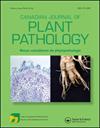Development of optimized Verticillium longisporum inoculation techniques for canola (Brassica napus)
IF 1.6
4区 农林科学
Q3 PLANT SCIENCES
引用次数: 1
Abstract
Abstract Verticillium stripe, caused by Verticillium longisporum, is an emerging soilborne disease of canola (Brassica napus) in Canada. Improved inoculation protocols will facilitate study of Verticillium stripe and its management. Two inoculation techniques, a root-dip method at two inoculum concentrations and a grain inoculation method at four inoculum concentrations, were compared under greenhouse conditions with the canola cultivars ‘45H31’, ‘CS2000’ and ‘Westar’. Symptoms of Verticillium stripe appeared at early growth stages following root dip inoculation, resulting in seedling mortalities of up to 19.7%, 39.5% and 33.3% for ‘CS2000’, ‘45H31’ and ‘Westar’, respectively, at 35 days post-inoculation. Plants inoculated by the root-dip method incurred much greater mortality at the high versus low inoculum concentration. In the surviving adult plants, ‘45H31’ was moderately resistant while ‘CS2000’ was more susceptible to V. longisporum. The grain inoculation method did not cause early-stage mortality, although Verticillium stripe severity at the adult stage was significantly different between control and high inoculum concentrations for all cultivars. In addition, plant dry weight and height decreased as inoculum concentration increased. Inoculation of 1-week-old, 2-week-old and 3-week-old seedlings of ‘CS2000’ and ‘Westar’ was also compared by the root-dip method. The impact of host age at inoculation on disease development was not significant, although higher disease severity was observed at later inoculation in ‘CS2000’. The application of grain inoculum may be more suitable for large-scale screening or studies conducted under field conditions.油菜籽长孢黄萎病菌接种技术优化研究
摘要条纹黄萎菌是由长孢黄萎菌引起的一种新发的加拿大油菜土传病害。改进的接种方案将有助于黄曲霉条纹及其管理的研究。在温室条件下,将两种接种技术,即两种接种浓度下的浸根法和四种接种浓度的谷物接种法与油菜品种“45H31”、“CS2000”和“Westar”进行了比较。在生根接种后的早期生长阶段出现了黄曲霉条纹症状,导致“CS2000”、“45H31”和“Westar”在接种后35天的幼苗死亡率分别高达19.7%、39.5%和33.3%。用浸根法接种的植物在高接种浓度和低接种浓度下的死亡率要高得多。在存活的成年植株中,‘45H31’具有中度抗性,而‘CS2000’对长孢霉更敏感。谷物接种方法没有导致早期死亡,尽管所有品种在成年期黄萎病菌条纹的严重程度在对照和高接种浓度之间存在显著差异。此外,随着接种物浓度的增加,植株干重和株高降低。用浸根法对‘CS2000’和‘Westar’1周龄、2周龄和3周龄幼苗的接种情况进行了比较。接种时宿主年龄对疾病发展的影响并不显著,尽管在“CS2000”后期接种时观察到更高的疾病严重程度。谷物接种物的应用可能更适合在田间条件下进行大规模筛选或研究。
本文章由计算机程序翻译,如有差异,请以英文原文为准。
求助全文
约1分钟内获得全文
求助全文
来源期刊
CiteScore
4.50
自引率
5.00%
发文量
56
审稿时长
6-12 weeks
期刊介绍:
Canadian Journal of Plant Pathology is an international journal which publishes the results of scientific research and other information relevant to the discipline of plant pathology as review papers, research articles, notes and disease reports. Papers may be submitted in English or French and are subject to peer review. Research articles and notes include original research that contributes to the science of plant pathology or to the practice of plant pathology, including the diagnosis, estimation, prevention, and control of plant diseases. Notes are generally shorter in length and include more concise research results. Disease reports are brief, previously unpublished accounts of diseases occurring on a new host or geographic region. Review papers include mini-reviews, descriptions of emerging technologies, and full reviews on a topic of interest to readers, including symposium papers. These papers will be highlighted in each issue of the journal and require prior discussion with the Editor-in-Chief prior to submission.

 求助内容:
求助内容: 应助结果提醒方式:
应助结果提醒方式:


